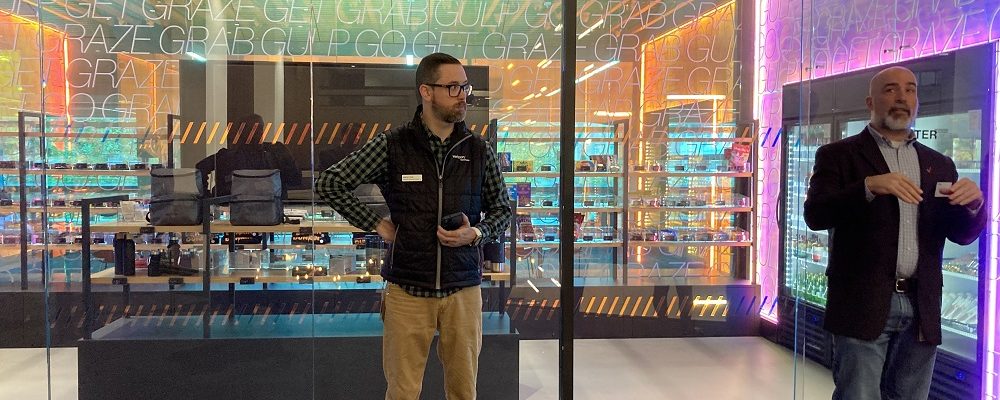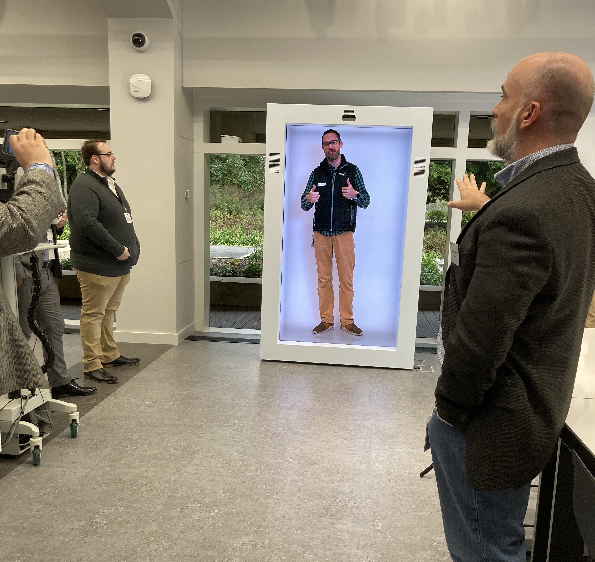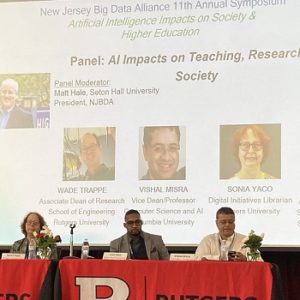Verizon Execs Walk Us Through Futuristic 5G Applications That Are Working Now
In October, NJTechWeekly.com attended an event at Verizon in Basking Ridge, where the communications giant took members of the press and others through a demonstration of its most innovative 5G-powered products to date. It was a lot of fun to see how far some of this technology has come.
One of the key takeaways is that companies that use private wireless 5G networks no longer need tons of hardware or immensely complicated setups. Verizon reps pointed out that a whole factory can be powered with hardware that can fit into a small rack. The system does require an array of radios distributed throughout the area.
The room we toured with Jason Stevens, technical operations manager at Verizon, and Jason Volk, technical operations manager at the company’s executive briefing program in Basking Ridge, serves as a “sandbox” for customers. “We let customers have fun with the network,” Stevens said. Customers can bring in devices and put them on the network to experiment with them.
A demonstration of Verizon’s holographic communications technology | Esther Surden
At one point, Volk demonstrated a hologram over a private wireless network that was developed by Verizon in cooperation with Proto (New York), a holographic communications company. “What we’re able to do with this system is basically bring a close-to-lifelike version of yourself into any faraway location. Think celebrity guest appearances, where you want to bring an individual into an environment. Maybe you’re opening a retail store, or maybe it’s a stadium, and you want to bring an athlete in to meet season ticket holders,” said Stevens. “The cool thing with the technology is it’s completely two ways. So there’s cameras and microphones mounted in the box.”
Another exhibit involved a small robot that could avoid humans who got in its way. Attendees also had the opportunity to “shop” at a convenience store setup for employees that uses opt-in facial-recognition technology to confirm who is shopping, as well as multiple cameras mounted on the ceiling to figure out if someone has put something in their basket. The 5G EDGE Cashierless Checkout technology can even tell if a person takes something out of their basket and leaves it on a different shelf. Employees can just walk in and walk out with what they want.
One of Verizon’s most recognized applications involves installing 5G networks at National Football League (NFL) and National Basketball Association (NBA) stadiums for both consumers and venue operators. “Previously, only consumers were benefiting. Now we are letting venue operators benefit from that same network capacity and start to deploy solutions that would improve their operations or improve the fan or spectator experience,” Stevens said.
One of the stadium applications involves accelerated access through facial authentication. Stevens explained the application this way: “This is a fully opt-in solution. We’re not mandating that anyone use this. But many of you who came here today may have been presented with an option to do facial authentication as part of your visit here. You may have noticed that there were iPads out front, because iPads are capable of scanning QR codes and bar codes, but also have the ability to do facial authentication.”
He continued, “So, the beauty of facial authentication is: Think about ticketing for a venue, right? Buy your ticket through Ticketmaster or some other type of ticket outlet. Those tickets are already delivered to you digitally to your phone, and you’re downloading the ticket. Then you get a QR code or bar code, and then you go to the venue and you’re fumbling, trying to scan tickets in and out, right? This is the same capability we are using, but it lets you use your face, have your tickets associated with that, redeems your tickets, and then just lets you pass through the gate.”
Event participants and Verizon employees were the subjects of a demo showing how 5G can be used in crowd control and crowd analytics. “What we’ve done here at headquarters is install LiDAR [Light Detection and Ranging] sensors. … And what a LiDAR sensor allows us to do is basically track human bodies as they’re moving through the environment. … It’s anonymized data. It’s not tracking identity. It’s not looking at individuals as far as different demographics of individuals. But the LiDAR has the capability of detecting human shapes and human forms,” he said.
Stevens pointed to a screen and said that a blue dot on the screen represents an individual. The artificial intelligence (AI), he said, can extract information from the data being collected and predict ingress and egress, dwell and wait times, traffic-flow patterns and congestion points.
“That allows them [stadium management] to create dynamic staffing plans to better discern where they want to put certain resources. … We’re able to take all this same information and then ultimately hand that back to the spectator through dynamic digital signage or mobile APIs. So, imagine you go to the stadium and it’s equipped with crowd analytics. You now know which gate has the shortest line, you know which convenience stands or hamburger and hotdog stands have a short line, you know where to get to your food, how to get there easier from point A to point B, with the help of wayfinding.”
The NFL is also using a newer application — Verizon’s Managed Private Wireless solution — in all of its 30 stadiums for on-field coach-to-coach communications. “They wanted to take a proactive approach to improve and protect the integrity of football. … And, as the stadiums are growing more and more advanced, more and more complex via the integration of a variety of different technologies, RF [radio frequency] congestion has become an area of concern.” The NFL wants to “separate the field operations from communications.” The private wireless solution operates with radios on the field.





